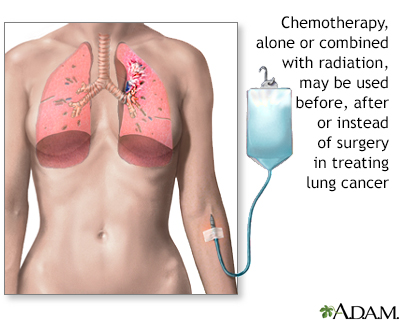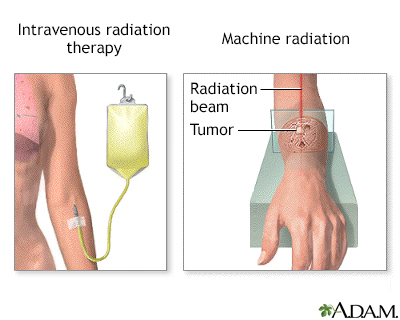Pregnancy SmartSiteTM
DefinitionIf you have cancer, your health care provider will recommend one or more ways to treat the disease. The most common treatments are surgery, chemotherapy, and radiation. Other options include targeted therapy, immunotherapy, laser, hormonal therapy, and others. Here is an overview of the different treatments for cancer and how they work. Surgery Surgery is a common treatment for many types of cancer. During the operation, the surgeon takes out the mass of cancerous cells (tumor) and some of the nearby tissue. Sometimes, surgery is done to relieve side effects caused by a tumor. Chemotherapy Chemotherapy refers to medicines used to kill cancer cells. The medicines may be given by mouth or into a blood vessel (IV). Different types of medicines may be given together at the same time or one after the other. Radiation Radiation therapy uses x-rays, particles, or radioactive seeds to kill cancer cells. Cancer cells grow and divide faster than normal cells in the body. Because radiation is most harmful to quickly growing cells, radiation therapy damages cancer cells more than normal cells. This prevents the cancer cells from growing and dividing, and leads to cell death. The two main types of radiation therapy are:
Targeted Therapies Targeted therapy uses medicines to stop cancer from growing and spreading. It does this with less harm to normal cells than other treatments. Standard chemotherapy works by killing cancer cells and some normal cells. Targeted treatment zeroes in on specific targets (molecules) in cancer cells. These targets play a role in how cancer cells grow and survive. Using these targets, the medicine disables the cancer cells so they cannot spread. Targeted therapy medicines work in a few different ways. They may:
Targeted therapies are given as a pill or IV. Immunotherapy Immunotherapy is a type of cancer treatment that relies on the body's ability to fight infection (immune system). It uses substances made by the body or in a lab to help the immune system work harder or in a more targeted way to fight cancer. This helps your body get rid of cancer cells. Immunotherapy works by:
These medicines are designed to seek and attack certain parts of a cancer cell. Some have toxins or radioactive substances attached to them. Immunotherapy is given by IV. Hormonal Therapy Hormone therapy is used to treat cancers that are fueled by hormones, such as breast, prostate, and ovarian cancers. It uses surgery, or medicines to stop or block the body's natural hormones. This helps slow the growth of cancer cells. The surgery involves removing organs that make hormones: the ovaries or testes. The medicines are given by injection or as pills. Hyperthermia Hyperthermia uses heat to damage and kill cancer cells without harming normal cells. It may be used for:
The heat is delivered from a machine outside the body or through a needle or probe placed in the tumor. Laser Therapy Laser therapy uses a very narrow, focused beam of light to destroy cancer cells. Laser therapy can be used to:
Laser therapy is often given through a thin, lighted tube that is put inside the body. Thin fibers at the end of the tube direct the light at the cancer cells. Lasers are also used on the skin. Lasers are most often used with other types of cancer treatment such as radiation and chemotherapy. Photodynamic Therapy In photodynamic therapy, a person gets a shot of a medicine that is sensitive to a special type of light. The medicine stays in cancer cells longer than it stays in healthy cells. Then, the doctor directs light from a laser or other source at the cancer cells. The light changes the medicine to a substance that kills the cancer cells. Cryotherapy Also called cryosurgery, this therapy uses very cold gas to freeze and kill cancer cells. It is sometimes used to treat cells that might turn into cancer (called pre-cancerous cells) on the skin or cervix, for example. Providers can also use a special instrument to deliver cryotherapy to tumors inside the body, such as the liver or prostate. ReferencesAmerican Cancer Society website. Treatment types. www.cancer.org/treatment/treatments-and-side-effects/treatment-types.html. Accessed March 19, 2024. Doroshow JH. Approach to the patient with cancer. In: Goldman L, Cooney KA, eds. Goldman-Cecil Medicine. 27th ed. Philadelphia, PA: Elsevier; 2024:chap 164. National Cancer Institute website. Types of cancer treatment. www.cancer.gov/about-cancer/treatment/types. Accessed March 19, 2024. | ||
| ||
Review Date: 12/31/2023 Reviewed By: Todd Gersten, MD, Hematology/Oncology, Florida Cancer Specialists & Research Institute, Wellington, FL. Review provided by VeriMed Healthcare Network. Also reviewed by David C. Dugdale, MD, Medical Director, Brenda Conaway, Editorial Director, and the A.D.A.M. Editorial team. View References The information provided herein should not be used during any medical emergency or for the diagnosis or treatment of any medical condition. A licensed medical professional should be consulted for diagnosis and treatment of any and all medical conditions. Links to other sites are provided for information only -- they do not constitute endorsements of those other sites. No warranty of any kind, either expressed or implied, is made as to the accuracy, reliability, timeliness, or correctness of any translations made by a third-party service of the information provided herein into any other language. © 1997- A.D.A.M., a business unit of Ebix, Inc. Any duplication or distribution of the information contained herein is strictly prohibited. | ||


 Lung cancer - chem...
Lung cancer - chem... Radiation therapy
Radiation therapy
